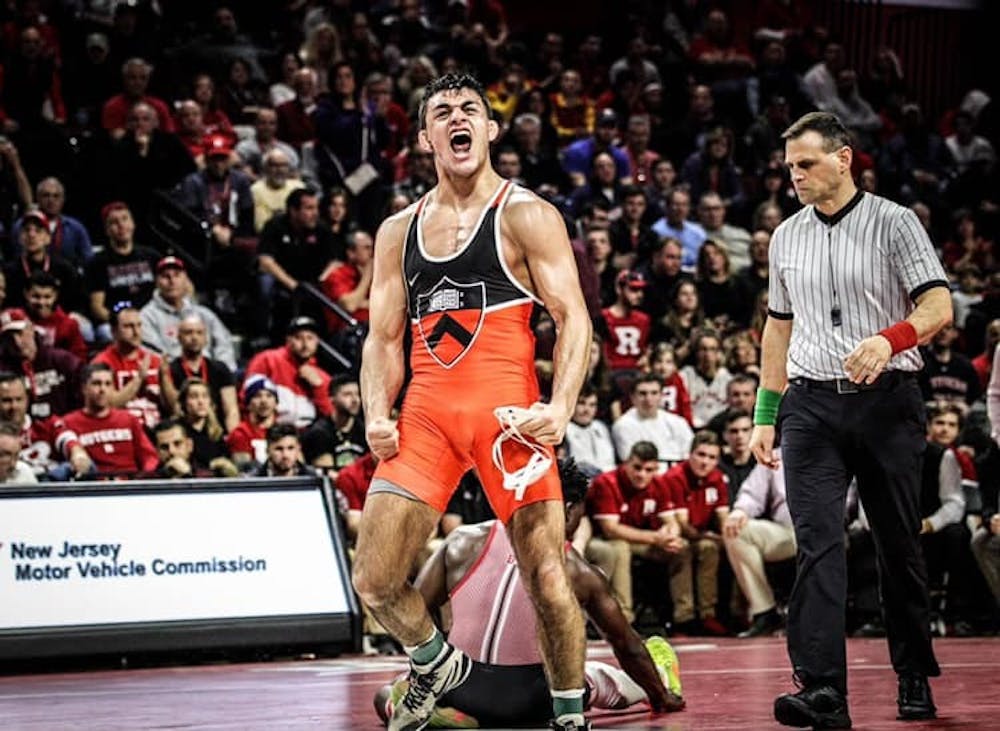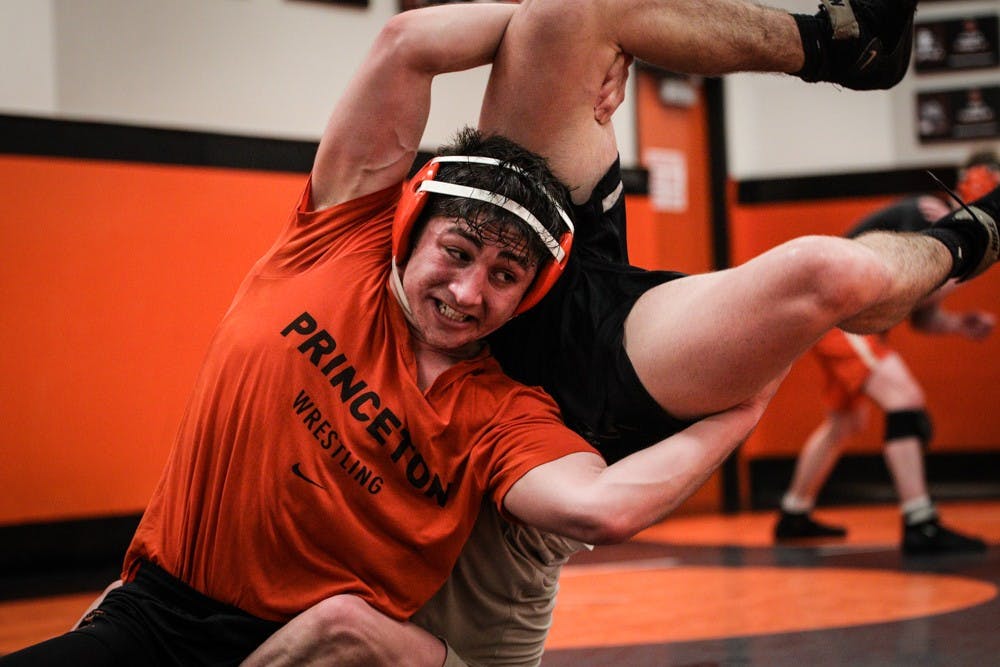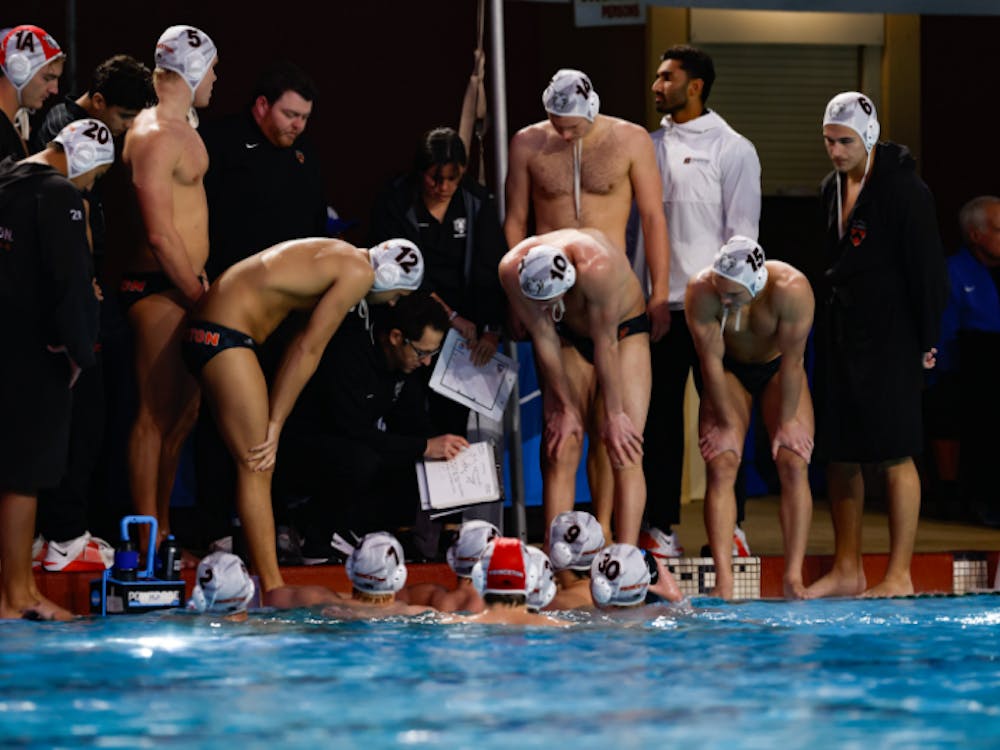When it comes to their weight, Princeton’s wrestlers have heard it all — and most of it is not flattering.
“When I tell people I’m a Division I wrestler,” said first-year Travis Stefanik, “the first thing they assume is that I’m starving myself.”
Princeton’s athletes want to set the record straight. While none denied the challenges of shedding weight, wrestlers questioned the scrutiny that surrounds the practice and defended the discipline it requires.
“It’s an absolute myth that wrestlers starve themselves or haven’t eaten or drank water in days,” said sophomore captain Patrick Brucki.
Making weight is as central to wrestling as takedowns themselves. Athletes compete in one of 10 weight classes: 125, 133, 141, 149, 157, 165, 174, 184, 197 pounds, or heavyweight, which accommodates wrestlers up to 285 pounds.
In an attempt to attain the greatest possible strength-to-mass ratio, athletes typically sit significantly above their competition weight. They drop down to their designated class as their matches near. If a wrestler measures above his standard, he does not compete.
Making weight is a “necessary and difficult part of ensuring fair competition,” said junior captain Matthew Kolodzik. “We’ve come a long way in making it much healthier than it was 30 years ago, and the sport is much better for it.”
An in-depth examination of the history of making weight and its practice on the University’s campus counters the popular narrative of starvation, dehydration, and self-inflicted torture. It reveals a coaching staff committed to the health of its athletes, and a team culture that — while admittedly alien to the outsider — is dedicated to managing weight rather than cutting it.

“Swimming in a Pool of Gatorade:” Wrestling’s Tainted History
Collegiate wrestling is rich in weight-loss horror stories: competitors abusing laxatives, forcing themselves to sweat in rubber suits, and shedding dozens of pounds in as few hours.
Princeton’s head wrestling coach, Christopher Ayres, has tales of his own to share from his time at Lehigh University in the 1990s. He once lost 14 pounds in 38 hours, a feat that involved “four two-hour workout sessions, lots of stationary biking and trips to the sauna, and minimal eating and drinking.” The endeavor was accompanied by serious consequences. “My body didn’t work right,” he said. “I remember moments in the match where I literally just could not react.”
In a Jan. 16 tweet, Ayres recalled the psychological challenges of making weight: “When I was cutting weight hard I would have dreams of swimming in a pool of Gatorade with my mouth open.”

For decades, Ayres’s experience was universal among collegiate wrestlers. Throughout most of his competitive career, the NCAA Wrestling Committee’s restrictions on cutting weight were few and far between. Wrestlers could shed pounds nearly any way they saw fit — which oftentimes meant prioritizing efficacy over health.
One NCAA standard proved particularly troublesome: the 24-hour weigh-in. Wrestlers checked into their weight classes the day before a match. In theory, that gave them a significant chunk of time to recover from the strain of cutting pounds. Reality proved more bleak.
With a full 24 hours to recuperate, wrestlers could afford to be reckless in their weight-loss strategies, pushing themselves to critical states without worrying about undermining their performances. A comprehensive 1994 study found that on average, collegiate wrestlers cut a drastic 7.8 percent of their body mass in the single day before weigh-ins. That left them in compromised condition to compete.
“The days of the 24-hour weigh-in were scary,” Ayres said.
The 1995 postseason saw two wrestlers hospitalized for severe dehydration, but the sport’s governing body made no move to modify regulations. “Although the weight-loss subcommittee recognizes that there are incidents of wrestlers using improper weight-loss methods,” read a memo drafted by the NCAA Wrestling Committee, “the group raised the question as to why and how this necessarily constitutes a problem for the sport of college wrestling.”
Two years later, that question was answered. Within a 35-day period over the winter of 1997, three collegiate wrestlers died from last-minute attempts to shed pounds before weigh-in. NCAA Wrestling faced renewed scrutiny from state prosecutors, the Food and Drug Administration, and the American public. The organization swiftly rethought its weight regulations.
In one sweeping move, the Committee outlawed most traditional weight-loss methods. Wrestlers were prohibited from using diuretics, laxatives, self-induced vomiting or saunas to shed pounds. They could no longer train in rubber or plastic suits. Training rooms could not exceed 80 degrees. (This limit has since been reduced to 75 degrees.)
The NCAA also scrapped the 24-hour weigh-in. Instead, wrestlers weighed in a maximum of two hours before the start of their matches. Collapsing the time between weigh-in and competition meant wrestlers could no longer slash weight at the expense of their health.
Additionally, the Committee obligated each affiliated program to set a minimum weight at the beginning of the season for each of its wrestlers using two factors: his lowest allowable body fat percentage (5 percent), and a projected metric of his greatest possible ‘healthy weight loss’ over the course of the year (1.5 percent of his body weight per week of the season).
In 2017, the NCAA yet again updated its policies, approving a ‘weight-allowance’ rule. In both dual meets and tournaments, wrestlers were permitted a one-pound surplus for each extra day of competition, an allowance that continues to this day. Additionally, the Committee imposed stiffer penalties for violations of weight-associated protocol.
And finally, NCAA Wrestling took it upon itself to rename the practice that had caused it so much trouble. Gone were the days of “weight loss.” Here were the days of “weight management.”

Dale Tiongson basks in victory after a match win.
Photo Credit: Tanvi Kishore for the Daily Princetonian
“We Don’t Cut Weight Here:” A Controversial Practice on Princeton’s Campus
“Weight management” is the phrase employed by Ayres and his athletes, all quick to distance themselves from the negative stereotypes of their sport.
“At Princeton, you can’t possibly be a weight-cutter and do school and deal with the stresses you feel,” Ayres said. “As a team, our basic philosophy is that we want guys to wrestle the weight they’re comfortable at.”
Ayres wants his wrestlers conditioned, not depleted. There exists a fine line between the two, and at a university as academically rigorous as Princeton, that line gets finer.
Ayres’ approach seems unconventional, even to some of his own wrestlers. During the program’s turnaround six years ago, Ayres brought in his most highly touted recruiting class to date. In practice, the first-years surpassed all expectations. Come competition, they disappointed. Ayres was beside himself. After two months, he made an unexpected decision.
“I got the five kids in a room and told them they were all moving up a weight class,” he said. “They were surprised — but it ended up the best dual season we’d ever had.”
Kolodzik, the junior captain, recalls watching his brother, Daniel Kolodzik ’12, undergo a similar experience, and benefit from it. “My brother was the one telling my coach that he wanted to cut weight. But when he stopped, he started wrestling better and was way happier,” he said. “To this day, Coach Ayres says that the best decision he ever made was telling my brother that he couldn’t cut weight.”
That is not to say weight is a non-issue for Princeton’s wrestlers. Each of them still hovers five to 10 pounds above his competition standard, methodically shedding pounds as each in-season week progresses. The amount each wrestler forces himself to lose, however, is significantly less than it would have been a decade ago.
Ayres’ friendly philosophy of ‘comfortable weight’ includes one caveat. “If there’s a hole in our lineup,” he explained, “they’ll have to sacrifice something.”
Princeton’s roster found itself with one of those holes this season. In the absence of a standout heavyweight wrestler, Ayres asked sophomore Kendall Elfstrum to step up to the plate — fork and knife in hand.
His senior year of high school, Elfstrum won the 195-pound New York State title. He entered his freshman season at Princeton competing in the 184-pound weight class. He now wrestles as a heavyweight — a division that accommodates competitors between 197 and 285 pounds.
“He came in expecting to wrestle 184 again this year,” explained Stefanik. “Now he’s hovering around 210.”
“You Can’t Be Eating Cheesesteaks:” The Process of ‘Weight Management’
At its core, weight maintenance is a personal endeavor. Each wrestler employs his own finely honed strategy: when to start, what foods to cut, how to keep his metabolism running fast.
Patrick Brucki stands at six feet even. He wrestles at 197 pounds: in the offseason, he sits at 215. Five-foot-5-inch first-year Patrick Glory wrestles at 125 pounds, the NCAA’s lightest weight class. Both of them lose 2 percent — the NCAA’s maximum-allowed amount — of their body weight a week during the season.
Brucki starts his drop two or three days before competition. “I cut out big meals in my diet,” he said.
“I’ll snack more consistently – smaller meals, but more of them. I keep my caloric intake high. You can’t be eating sweets or cookies or greasy food. You want to fuel your body.”
Early each week, Glory sits at 130 pounds. He aims to shed “a pound in the beginning of the week, a pound as the week goes on.” But he doesn’t stress too much. “It’s not bad if you’re within striking distance,” he said. “I can get off four pounds easy in a practice.”
As for Glory’s diet, he slims down with “mostly salads — a lot of water. Maybe some chicken or vegetables here and there.” He laughed. “You can’t be eating cheesesteaks.”
Despite the wrestlers’ matter-of-fact descriptions, weight maintenance is by no means an easy task. If anything, the athletes enjoy the challenge. “Is it hard?” asked Brucki. “Yeah. It’s not supposed to be easy. But it makes you better because of that.”
Self-discipline plays a primary role, but the coaching staff remain heavily involved in the process. “If guys are having trouble getting down to weight,” said Ayres, “I’ll have them take pictures of what they’re eating and send them to me.”
That might seem a domineering approach to some. But not to the wrestlers. Kolodzik, for one, often asks Ayres to check his weight throughout the week during practice.
“I know if I don’t have a goal, I’ll slack,” he said. “It’s one thing when you’re letting yourself down. It’s another when you’re letting down your coaches.”
Team members work as a group to avoid those disappointments. “Everyone’s doing it together, going to the dining hall and eating together, drinking together,” said Glory. “Having a process like that makes your body feel good, instead of feeling fat for the four days before the weigh-in and then sucking everything out.”
Evidently, “fat” means something different for Princeton’s wrestlers than it does for the rest of the world.
Princeton’s wrestlers enjoy resources beyond the expertise of their coaches. All varsity athletes share access to a clinical and sports dietitian, Alexa McDonald, who is employed through University Health Services.
McDonald deferred questions about UHS’s athletic protocols to director of medical services Dr. Jonathan Pletcher. Pletcher declined to speak with a reporter. In an email, however, he wrote, “the scope and specificity [of weight-loss protocols] would be impossible to convey in an interview.”
In the rare occasion that a wrestler is truly struggling to make weight, Ayres will send him in for a consultation with McDonald. Athletes like Glory, who have met with McDonald, have found her guidance helpful. But most of the time, the wrestlers trust their team and their coaches’ advice when it comes to weight maintenance.
“I [subscribe] to the belief that if you’re never done it, you don’t know how to do it well,” said Ayres. “A nutritionist can sometimes be a huge help. But we know a lot about making weight on our own.”

Noah Arjim sweats during a match in practice.
Photo Credit: Tanvi Kishore for the Daily Princetonian
“It’s Actually Really Healthy:” Wrestlers and Professionals Weigh in
Making weight “is hard,” said Glory. But he insisted that the priorities it promotes — drinking water, paying careful attention to what you consume, and exercising — will “actually make you healthier.”
Glory’s assertion is undeniably bold. But it does align with the professional consensus, provided that weight is managed responsibly.
An authoritative 2009 paper — co-authored by Aimee Gibbs of the Virginia Department of Health and Joel Pickerman and Jon Sekiya of the University of Michigan’s Athletic Medicine department — outlined the safest practices associated with wrestlers’ weight-management.
The guidelines included not losing more than 1.5 percent body fat per week, avoiding large fluctuations in weight during the offseason, and maintenance of adequate hydration and calorie consumption.
A bodybuilding competitor and coach, New Jersey registered dietitian Sarah Currie has worked with and trained many former wrestlers. She cited long-term effects of weight fluctuation like metabolic damage and chronic kidney failure. Her recommendations for best practices were nearly identical to Gibbs, Pickerman, and Sekiya’s.
Princeton’s weight-loss practices fall in line with those professional recommendations. Athletes are adamant that they never lose more than 2 percent of their body weight — the NCAA standard — per week. They eat small, well-timed meals and are careful to remain hydrated throughout the day.
That is not to say that all is smooth sailing for the athletes.
“Every wrestler has probably had a bad weight cut,” said Brucki. But he insists that “it’s the wrestler’s fault, not the sport’s fault. It’s the wrestler’s fault for losing discipline in his preparation and training. I take full responsibility for any issue I’ve ever had.”
To the researchers, even responsible weight management can pose a psychological threat: namely, the development of a “distorted weight loss mindset.”
“Any sport that you need to stay lean for has high risks of body image dysphoria,” Currie said. “There are hundreds of athletes on the disordered eating spectrum.” For men, sports that require weight management — notably wrestling, rowing, and horseracing — are associated with the highest rates of eating disorders and disordered eating.
Ayres dismissed those concerns. “At the highest level,” he said, “I’ve never seen that happen.” Kolodzik adamantly denied that disordered eating or body image was an issue for his team.
“I Appreciate Food:” Inside the Weight-Loss Mentality
Wrestler after wrestler argued that years of weight-management had actually benefited his psychological well-being.
“Once college is over, who are you going to be?” asked Glory. “What are you going to eat? What’s your lifestyle going to be? I think that having this discipline is really going to be something that’s going to benefit me long-term. ”
Brucki echoed that sentiment.
“It’s a blessing that I’ve had the luxury of being able to make weight and be held accountable for my diet. It’s just one area of discipline and accountability that you cannot hide from. That kind of honest living is a reason why I’m grateful for the sport.”
Especially in light of improved regulation changes, wrestlers resent the intense criticism their sport faces for what they view as a wholly beneficial practice. Kolodzik bemoaned having to “poorly explain the phenomenon” over and over again to judgmental outsiders.
“It cracks me up that people come up to us and say weight cutting isn’t good,” said Ayres. “In the country, there’s this huge obesity rate. People should be talking about that. They should be talking about football players gaining weight. Wrestlers have a healthy relationship with food. That’s really it.” Ayres insisted as well that the vast majority of competitive wrestlers maintain their levels of health and fitness after their collegiate careers end.
Brucki highlighted that stark national contrast as well. “If you look at the direction of today’s society, and the overall stereotypes of America, people just see Americans as lazy. It’s incredible we get held to a disciplined standard that not a lot of people are.”
Weight classes ensure fair competition in a sport where a slight physical advantage means an enormous leg-up. No matter the controversy they may spark, weight classes are here to stay. Wrestlers have had enough of this conversation. They are ready to step out of the spotlight.
In response to an initial request for an interview, Kolodzik demurred. “I don’t want the sport to get a worse reputation than it already has,” he said.
But when urged to open up, wrestlers prove eager to divulge the values, inaccessible to most, that their sport has instilled in them. Reality is straightforward: Wrestlers approach their food and their bodies in a wildly different way than the rest of us.
“The number one benefit to wrestling and making weight? Gratitude and appreciation,” said Ayres. “Sure, I don’t eat a lot. But I appreciate food. The bagel you eat after a weigh-in is the best bagel you’ve ever eaten. You’re not just stuffing your face. You’re thinking ‘I waited for this, I sacrificed for this.’”








